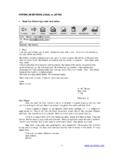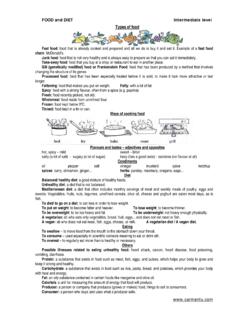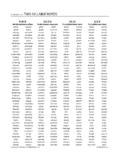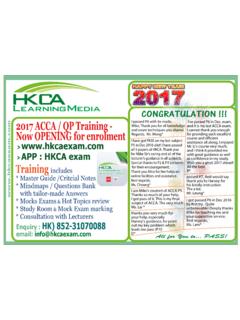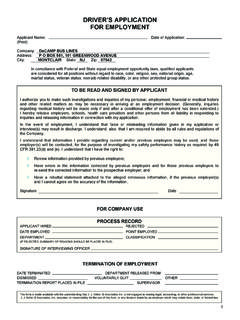Transcription of WRITING FORMAL E-MAILS AND LETTERS LEVEL: …
1 W RITIN G F O RM AL E- M AILS AN D L ETTERS LEVEL: advanced 2. FORMAL E-MAILS and LETTERS are sent to people you don't know well ( Director of Studies) or people in an official position, when you want to apply for a job or a course, to make a complaint, to ask for information about a trip, etc. They are written in a FORMAL style, in a polite, impersonal tone and they should be printed (not hand-written). Characteristics of FORMAL style: Vocabulary: Use advanced FORMAL vocabulary (don't use colloquial expressions): I am WRITING to enquire whether (NOT: I want to ask if ). Use words of Latin/French origin (not of Anglo-Saxon origin): investigate (not research ).
2 Use single-word verbs (not phrasal verbs): continue (not go on ). Use FORMAL linkers: consequently, furthermore, however, therefore, for this reason Use linkers to structure your text: first of all, in addition, finally : I have worked as a primary school teacher for ten years and therefore have experience working with children. Grammar: Use passive voice: be + past participle: I can be contacted (NOT: You can contact me ). Use long and complex (subordinate) sentences: I am WRITING to apply for the position of part-time shop assistant which was advertised in this week's edition of the Frankfurt English News. Don't use the imperative.
3 You may contact me by telephone at the above number. (NOT: Ring me at the number I've given you.). Punctuation: Use full forms of verbs, not abbreviated forms: I would be grateful if (NOT: I'd be grateful if ) I would like to apply (NOT: I'd like to apply ). Don't use exclamation marks. Structure of FORMAL E-MAILS and LETTERS : A FORMAL e- mail or letter should consist of: 1. A FORMAL greeting, there are two possibilities: Dear Sir/ Madam, / Dear Sir or Madam, when you don't know the person's name. Dear Mr Squires, / Dear Ms Braun, when you know the person's name, use the title (Mr, Mrs, Miss or Ms, Dr, etc.) and the surname only.
4 2. 1st paragraph: an introduction in which you write your opening remarks and mention your reason/s for WRITING . 3. 2nd / 3rd (etc) paragraphs: a main body in which you write the main subject(s) of the e- mail / letter in detail, starting a new paragraph for each topic. 4. Last paragraph: a conclusion in which you write your closing remarks. 5. A FORMAL ending, there are two possibilities: Yours faithfully, when you don't know the person's name. Yours sincerely, when you know the person's name. 6. Your signature and full name: sign your name on the left (use blue or black ink), then print it below the signature. Woodrow Wilson Differences between FORMAL E-MAILS and FORMAL LETTERS : In a FORMAL letter you write your address (street, city or village, postcode, maybe also telephone number and email address) without your name in the top right-hand corner.
5 Then, skip a line and write the date (on the right and below your address). Write the month as a word (25 April 2010). The date can be written in different ways: 18th December, 2010 / 18th December 2010/ 18 December 2010. Finally, the address of the person you are WRITING to should be written on the left, one line below the date. Include the person's full name (Emily Evans) if you know it, position of the person (The Personnel Manager) and/or name of the company, street, city or village, and postcode. In a FORMAL email you write your email address in the From field, and the email address of the person you are WRITING to in the To field.
6 Write a subject that will draw the attention of the reader. CARMEN LUISA P REZ AMARO 1. W RITIN G F O RM AL E- M AILS AN D L ETTERS LEVEL: advanced 2. LETTERS /Emails applying for a job/course: 1. Introduction: include the name of the job/course, where and when you saw it advertised: I am WRITING in response to your advertisement on (website) / in (newspaper) The Evening Standard of 9th May. Application for a job: I wish to apply for the post/position of office manager with DXW Insurance beginning in June 2010 advertised in . I am WRITING in connection with the vacancy in your Sales Department, as advertised in . Tenerife News on/of 20 November.
7 My bachelor degree combining communication and business courses as well as my work experience prepare me for this position. Application for a course: I am WRITING to apply for a place on the Archaeology MA course which commences this December at La Laguna University. I would like to apply for admission to the course. 2. Body paragraphs: in the body of your email/ letter you need to match yourself to the company/job or course. Also state your reason for applying/interest in the position/job. You should indicate: Your age, present job and/or studies: I am a nineteen-year-old university student. I am working as a cook in a school in Santa Cruz.
8 For the last year I have been working as . Two years ago I was employed as . Your qualifications: My academic background includes a BA in English and Communication with a concentration in Public Relations. Along with these areas of study, I hold a certificate in Business, Technical, and Scientific Communication. I have/hold a degree/diploma/certificate in Media Studies. I have recently finished secondary school. I have successfully completed a course in (subject) at (place). Your experience: summarise pertinent work experience for the job/course. Use the past simple (past jobs), present perfect (recent job) or present continuous (current job).
9 Last winter I was employed as (position) a cook by (company) in (place) from (date) to (date). I have worked as an assistant cook in several restaurants in Puerto de la Cruz for the last . years. At present I am employed/ working as . I have experience with children/ in public relations. Expertise in the field has given me a background which I believe could make me effective in your organisation. I was promoted to department manager in 2008. My position also involves/involved persuasive selling. My duties include/included . While working with Dr. Usala Hostetler at the East Carolina University School of Medicine for the past two years, I have been part of a team of researchers studying the adrenaline receptor gene and the thyroid receptor gene.
10 I enjoy working .. with DNA research and would like to continue doing so. Skills and personal qualities that are suitable for the job/course (use the present simple): I believe I am suitable for this job because I enjoy working with children. I also speak some French as well as Italian and English. I consider myself punctual and responsible. My strengths include being able to work well with a variety of personalities, to converse with anyone, and to enter easily into new situations with a creative and resourceful attitude. In addition, I am persistent and punctual. CARMEN LUISA P REZ AMARO 2. W RITIN G F O RM AL E- M AILS AN D L ETTERS LEVEL: advanced 2.
